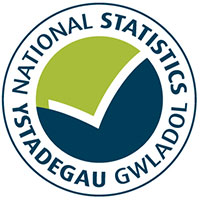Data on people’s ability in Welsh and how often they speak the language for July 2020 to June 2021.
This is not the latest release in the series: Welsh language data from the Annual Population Survey
The census of population is the key source used to measure the number of Welsh speakers in Wales. However, as the Annual Population Survey (APS) provides quarterly results, it is a useful source to look at trends in Welsh language ability between censuses.
Main points
- For the year ending 30 June 2021, the APS reported that 29.2% of people aged three or older were able to speak Welsh. This figure equates to around 884,300 people.
- This is 0.6 percentage points higher than the previous year (year ending 30 June 2020), equating to around 17,900 more people.
- The chart shows how these figures have been gradually increasing each year since March 2010 (25.2%, 731,000), after they had been gradually declining from 2001 to 2007. The number of people reporting to be able to speak Welsh decreased from December 2018 to March 2020, before increasing again since then. This increase should be treated with caution due to the change of survey mode since mid-March 2020 because of the coronavirus (COVID-19) pandemic. See ‘Changes to the survey’ below.
- The highest numbers of Welsh speakers continue to be found in Carmarthenshire (93,900) and Gwynedd (90,700).
- The lowest numbers of Welsh speakers are in Merthyr Tydfil (10,300) and Blaenau Gwent (11,200).
- The highest percentages of Welsh speakers can be found in Gwynedd (76%) and the Isle of Anglesey (66%).
- The lowest percentages of Welsh speakers are in Monmouthshire (16%) and Blaenau Gwent (17%),
- 15.4% (466,200) of people aged three or older reported that they spoke Welsh daily, 5.0% (151,900) weekly and 7.0% (213,400) less often. Around 1.7% (52,700) reported that they never spoke Welsh despite being able to speak it, with the remaining 70.8% not able to speak Welsh.
- 33.6% (1,018,300) reported that they could understand spoken Welsh, 25.9% (784,200) could read and 23.7% (718,200) could write Welsh.
Note
The Annual Population Survey (APS) is a UK-wide survey conducted by the Office for National Statistics (ONS). The APS, which began in 2004, is compiled from interviews for the Labour Force Survey (LFS), along with additional regional samples reaching an approximate sample of 320,000 respondents across the UK. In Wales, around 35,000 people are included in the survey each year. Details about how the survey is developed and carried out can be found on the Office for National Statistics website.
The census results and APS results for 2001 and 2011 have been included on the chart above to indicate the discrepancies between the two sources at the same time periods. There are a number of possible explanations for why census results would be lower than survey results. For example, the census is a statutory self-completion questionnaire while the APS is a voluntary survey, which uses face-to-face and telephone interviews.
The APS was re-weighted by the ONS in August 2021, for the period January to December 2020. For more information on the re-weighting, see the previous statistical headline for April 2020 to March 2021.
The APS results should not be compared with census results, nor used to measure progress towards the Welsh Government target of a million Welsh speakers by 2050. The Welsh language strategy, Cymraeg 2050, clearly states that this target was based on census data and that progress towards this target will be monitored using future census data.
A blog published by the Chief Statistician in 2019, gave a brief discussion on how to interpret the Welsh language data from the APS. More information about the differences between the APS and the census can be found in a bulletin presenting more detailed results on the Welsh language from the APS from 2001 to 2018.
Changes to the survey
Following government advice regarding the coronavirus (COVID-19) pandemic, the Annual Population Survey as well as all other ONS face-to-face studies about people, families and households were suspended. Further details of these changes can be found in this statement on the ONS website.
From mid-March 2020, the APS survey has been carried out by telephone only. A change in how a survey is administered can affect survey results. This set of results cover the period from July 2020 to June 2021, therefore all the interviews were carried out by telephone.
By comparing those who completed the survey over the telephone with those who completed the survey face-to-face in the period before March 2020, respondents did appear to be more likely to state that they could speak Welsh when answering the survey over the telephone.
At present, it is not possible to say whether any recent changes in Welsh language ability is as a result of the change in the way the survey is conducted, or real changes in the population’s ability in Welsh. The results should therefore be interpreted with caution.
Contact
Llio Owen
Telephone: 0300 025 5530
Email: welshlanguagedata@gov.wales
Rydym yn croesawu galwadau a gohebiaeth yn Gymraeg / We welcome calls and correspondence in Welsh.

